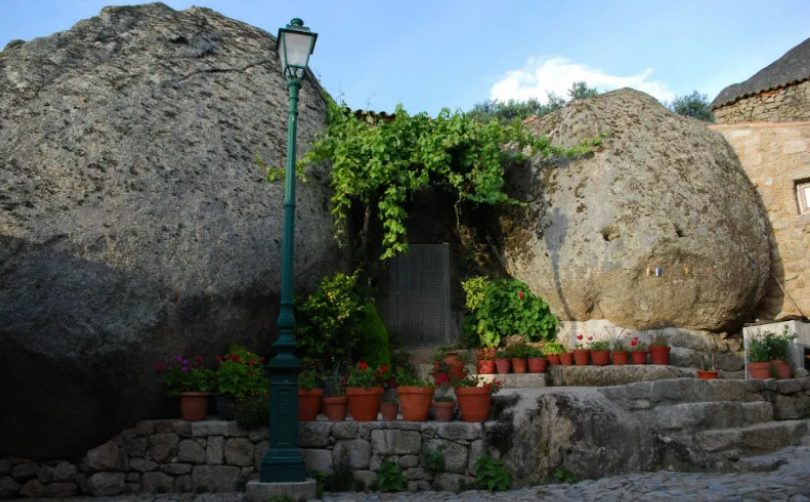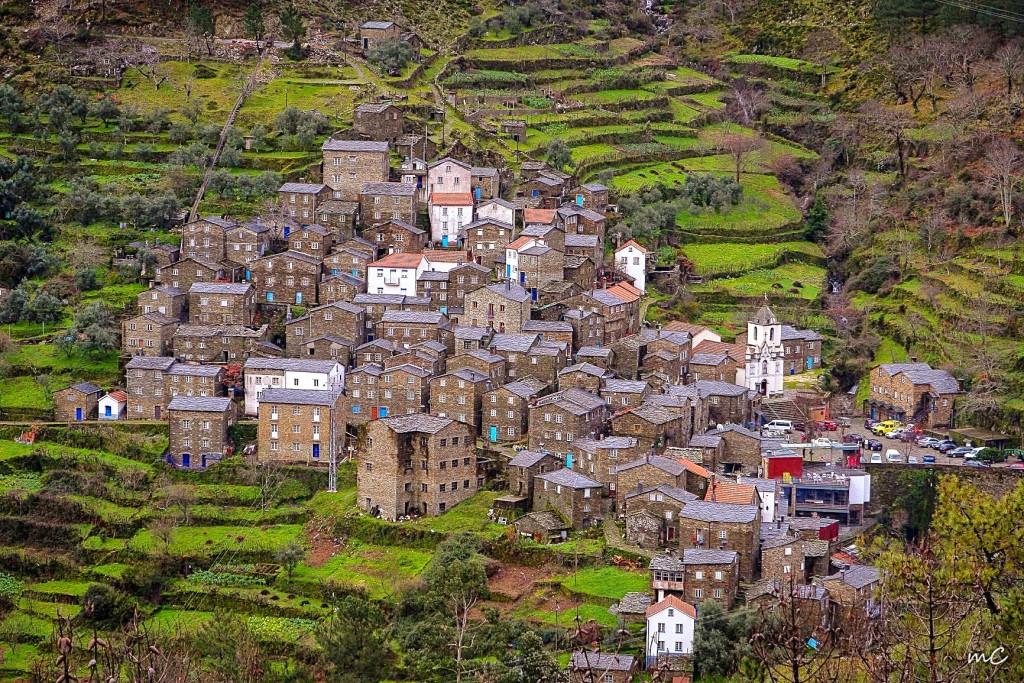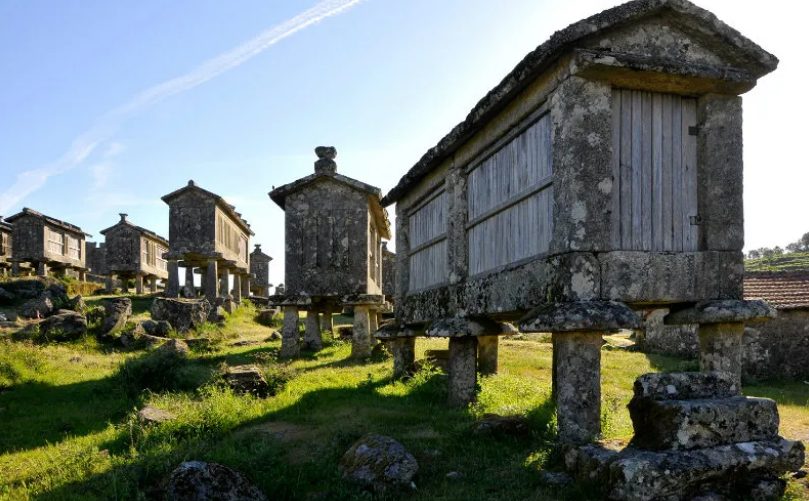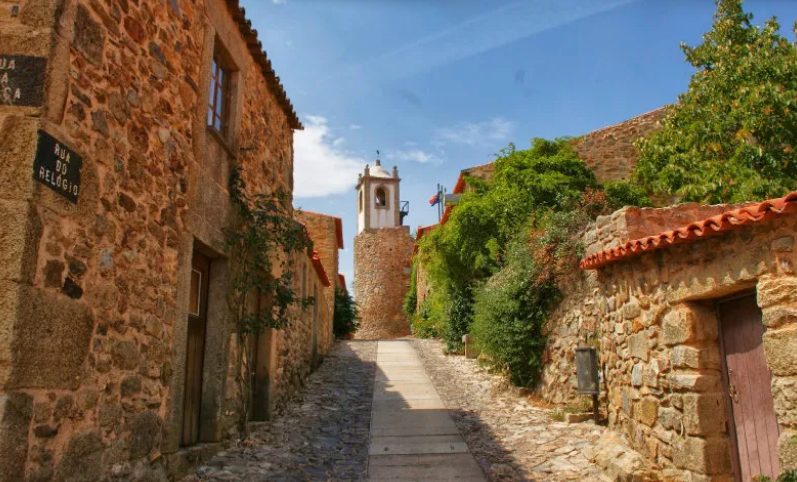Penha Garcia
I’m biased here, this is the village of my husband Bruno, but this is not the only reason it’s on the list. It has its own small canyon that you can see from the top of its own castle. Descend from the castle into the canyon on a marked path and you’ll see some pretty stone houses which purpose is to show you how people used to live in the past in the village.
Plus, one of the most famous attractions for locals (and Portuguese) are the fossils that are more than 490 million years old. This experience will make you feel more connected to nature and our ancient ancestors – the big bugs.
If you decide to stay in Penha Garcia, I’d recommend staying at Casal da Serra. This guesthouse is stunning. The views to the vast plainness make you feel like time has stopped. The hosts are very kind and caring and they will always be happy to share with you a story accompanied by chouriço and a glass of red wine. Plus, this house can be the base for exploring the next two villages.

Monsanto
is said to be the most Portuguese village of Portugal. Just a few kilometers away from Penha Garcia, there used to be a rivalry between the two villages in the old days. Now, this is not the case. However, one can argue which one is more beautiful.
When I first visited Monsanto, I was amazed by the houses, incorporating enormous round rocks in their structure. I recommend you to get lost in the small streets until you reach the castle.
On the way back, stop at Taverna Lusitana. They have the best toasts ever, and they don’t use the usual sandwich bread. Everything is local produce, from the bread to the presunto and cheese. Just sit outside and enjoy the beautiful view of the endless, burned by the sun plains.

Belmonte
Belmonte is a pretty little village, hidden in the Beira Baixa region. If you are or have any ancestors that are Jewish, this place will be of a special interest for you. There are walls of a castle with beautiful views, plus some museums that will help you fill in the time you have now, since you’ve unplugged.
Check the Jewish museum to understand the village history. Go to the museum of Olive Oil to understand how it’s produces. Or visit the Museum of Discoveries, to understand the Portuguese history. The building once belonged to Cabral family. Álvares Cabral is one of the great sailors of Portugal, just like Vasco da Gama, and Belmonte is his birthplace.
And don’t forget to enjoy the great food.

Piódão
If you dream of seeing rice terraces, but this year you won’t be able to make it to Asia, look no further than Piódão. Although with the locals it’s mostly famous for the houses made of Xisto – schist, a special rock, that is to be found in the region.Located in the fascinating landscape of the Serra do Açor, the village of Piódão offers the perfect mixture of history and nature. Some of the best sights to visit are the main church, the Chapel of Saint Peter, the Museum Quarter and the Fountain of Algares.

Lindoso
Lindoso is located in the beautiful Peneda-Gerês National Park, known to be the lungs of the country. But the natural beauty and rich history aren’t for me the only thing that makes it a must-see. It’s very famous for its granite “espigueiros”, resembling a tomb. They actually serve for keeping the corn and cereals off the ground, while drying, and thus away from rodents. They are still functional nowadays.
Another attraction is a bit outside of the village – take the Watermills Trail that will bring you to the cold waters of Poço da Gola. Only bathe (inside), if you feel very hot. The village itself has some monuments as a castle, church, etc. worth visiting.
Nature and monuments were covered, the only missing from the equation is food. The Beiras Altas (High Country) is famous for its fatty and delicious food. Some of the local dishes you’ll be able to savor are Pork in Minho style, cozido à Portuguesa (traditional stew with different kinds of meat and vegetables), roasted lamb, Barrosa beef, smoked meats, honey. The region is also the home of vinho verde – the amazing Portuguese green wine.

Castelo Rodrigo
In Castelo Rodrigo, you have the opportunity to make a true journey through the history of humanity. The region is rich in remains of the Paleolithic and Roman era, and even of the passage of the Muslims.
The village of Castelo Rodrigo was the scene of intense struggles, conquests, and reconquest, which is still visible today in its structures. If you visit Castelo Rodrigo you shouldn’t miss the walls and the Castle, the Cristóvão de Moura Palace, the main church and the Pillory.

I hope that you enjoyed reading about these beautiful Portuguese villages, now it’s time to pack the bags and visit them.
Source: https://t24hs.com








